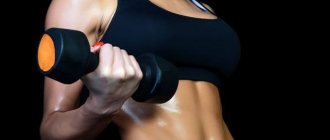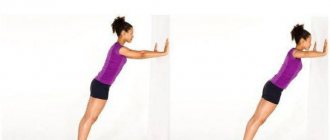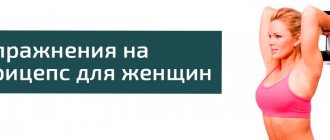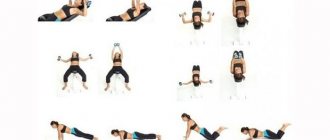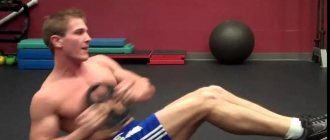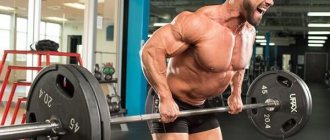Basic recommendations
Chest training is organized twice a week or with a break of at least two days. For beginners, a couple of basic exercises and no more than 3 approaches are recommended. Increased muscle mass gain is possible by increasing the number of approaches to six.
The work of the triceps is closely related to chest training, so the target load on these muscle groups should be separate.
Chest exercises in the gym are often basic; following the rules allows you to achieve truly tangible results, so theoretical knowledge will not hurt beginners.
Chest muscle training program
Perform two muscle group workouts during the week. The interval between them is no more than 72 hours.
Example of a “Chest + Back” training scheme:
- Horizontal barbell press – 4*8.
- Vertical thrust of the block – 4*10.
- Bench press on a bench with your head down – 3*8.
- Bent over row – 4*9.
- Dumbbell press at an angle of 30 degrees – 4*8.
- Shrugs with barbell/dumbbells – 4*12.
- Horizontal layout on the bench – 4*8.
Working weight – 50-75% of the one-repetition maximum in a specific exercise. The number of approaches and repetitions depends on the athlete’s preparation and the weight of the equipment.
The repetition range of 8-12 is conditional. Time under load is important for hypertrophy. To gain mass, perform a set in 15-30 seconds.
Exercises on parallel bars
Exercises for the pectoral muscles for men in the gym are worked out using this apparatus. This option is suitable for beginners and is performed in a lying position. The task actually works all muscle groups, including the arms, shoulders, and back.
The bars need to be placed at a distance slightly wider than the shoulders; in other options there may be risks of injury. The narrow arrangement of the parallel bars changes the load on the triceps and is suitable for use when it is necessary to train this part of the muscles. Technically, you need to take an emphasis on the uneven bars with straight arms. Such a start promotes muscle contraction and prepares for the next load. When doing this, it is recommended to tilt your body slightly forward and smoothly lower yourself, bending your elbows. At the bottom you need to linger a little and rise without jerking or abruptness. As you gradually straighten your arms, exhale.
A slow and smooth pace will avoid injury, which especially often happens to the elbow joints. To avoid this, it is recommended to turn your elbows to the sides, and when lifting, do not bring them closer to the body. A deep amplitude of execution will allow you to load the entire group of pectoral muscles. With insufficient movements, the load falls on the triceps.
Alexander Shestov
TRX Certified Trainer
Ask a Question
To maximize chest development, professionals use weights.
Features of training the pectoral muscles in the gym
During the approach, at the bottom point you need to stretch the muscle well, and at the top point you need to achieve a peak contraction. It is necessary that the main part of the load falls on the target muscle group and does not go into the stabilizer muscles. To do this, study the exercise technique and during the approach, concentrate on the muscle, think about how the pecs push the barbell up.
Using the bench press as an example, lowering the barbell or dumbbells, we rotate the pecs, stretching them at the lowest point. By squeezing the projectile upward, additionally strain the working group, achieving peak contraction. At the same time, do not straighten your arms completely, this way you will maintain the load in the pecs, not allowing it to partially go into the triceps.
About load and approaches
Mass-building training for the pectoral muscles is different from strength training. The differences relate to intensity and volume. Strength training is done using 75-90% of the weight of the repetition maximum, 1-2 exercises of 3-5 repetitions each.
Bodybuilding training is characterized by medium intensity and high volume. The work uses a weight of 50-75% of the one-repetition maximum, 2-5 exercises per muscle group, 4-6 approaches of 8-12 repetitions each. When training in this manner, you rest 30-90 seconds between sets, while strength athletes work at intervals of 5-10 minutes.
One-repetition maximum is the maximum weight with which an athlete can perform one repetition.
To achieve growth, use 2 to 5 exercises per muscle group per workout. Perform 4-6 sets of each exercise, 8-12 repetitions. Rest between sets for 30-90 seconds.
Don't use the same type of exercises . Perform inclined and horizontal presses, flyes, change the types of sports equipment. A bench with a 30-degree incline will allow you to pump the upper chest. The negative angle bench press engages the lower portion of the target muscle. The classic horizontal press targets the mid-sternum.
Alternate exercises for the chest and other muscle groups. This way you will avoid excessive release of catabolic hormones, which literally eat up the accumulated mass. Less destruction means more growth.
Isolation training
Such exercises are included by experienced athletes who know how to pump up their chest in the gym without basic training. These tasks are sometimes not enough to work the muscles; this method improves the muscle relief, resulting in better expressiveness.
It is recommended to perform the exercises at the end of training, while the base should be performed with maximum weight. Dumbbells play the role of the main insulating equipment.
Wiring
This task is popular even among beginners. Correct execution affects the development of one shoulder joint, but the main effort is concentrated on the pectoral muscles.
To start performing, it is recommended to take a sitting position, with your knees bent. The dumbbells are installed in a vertical position, and then a lying position is assumed. When raising your arms, your elbows should remain slightly bent; placing the dumbbells above your shoulders is recommended.
Lateral extension is performed up to peak capacity and fixation is recommended in this state. There is a feeling of stretching in the pectoral muscles, but there should be no pain. Reduction of the arms is performed while exhaling until the dumbbells touch.
During the process, it is important not to allow the elbows to straighten, otherwise injury to the joint may occur. The back must remain straight, otherwise the load will be placed not on the chest, but on the lower back. Equipment must be chosen of moderate weight.
Panatta offers
Global manufacturers have developed many types of equipment for breast work. Perhaps the most interesting offers are from the Italian company Panatta. Just look at the catalog of chest muscle trainers and it becomes clear what creative and effective solutions the manufacturer offers.
The model range includes a wide range of loaded and load-bearing models. They are produced within the Freeweight HP, XP Lux, Fit Evo, Monolith, Sec series. Moreover, there are solutions not only for performing isolating exercises, but also for basic exercises. In the Smith machine, for example, you can work out all the fascicles of the chest and achieve the inclusion of stabilizer muscles.
The Italian manufacturer sometimes takes a non-standard approach. Thus, it does not include the “Pek-Bek”, “Pek-Dek” and “Butterfly” models in one category. Yes, both types are designed to bring the hands together. Yes, they specifically work only target muscle groups. However, there is a difference between them. In “Peck-Beck” (a striking example is the multifunctional Peck Back from the SEC series), the arms are only slightly bent at the elbow. This feature allows you to work on different beams, and also includes the front deltas in the work. In “Pek-Dek” the arms are also brought together, but the elbows are bent and the forearms are rigidly fixed with supports.
The Panatta brand has more than a dozen solutions for chest training. You can get acquainted with them not only in the manufacturer’s catalog, but also on the website of Fitness Project - the official representative of the brand in Russia.
Tags: Gym equipment / professional strength training equipment / block weight training equipment / abdominal exercise equipment / professional cardio equipment / treadmills for fitness clubs / professional elliptical trainers / multifunctional strength training equipment
Pullover
Heavy weights are not recommended for chest exercises in the gym, so the fibers receive little stimulation. However, without this task, the rapid process of expanding the chest is impossible, so it is necessary in the training program.
To start performing, it is recommended to take dumbbells and place them with their ends next to the gymnastic bench. Then you need to lie down, placing only the upper back on the apparatus, the lower back is in a deflection, and the dumbbell is taken with both hands. The equipment rises above the chest, the arms are almost completely straightened.
Technically, the dumbbell needs to be lowered behind your head while inhaling and raised to its initial state. Movements in the exercise should be smooth, haste and abruptness are not allowed. Full straightening of the arms is not allowed, otherwise injuries to the elbows cannot be avoided.
If the projectile is lowered as low as possible, the pectoral muscles can be pumped very efficiently.
MINIMUM equipment to pump up your pectoral muscles at home
The very first thing you should have is a COLLAPSIBLE PAIR OF DUMBBELLS (from 5 to 40 kg each)! I have dumbbells at home weighing 20 kg each. This is already catastrophically not enough for me, but when I started, it was more than enough.
If your dumbbells are too light, you can train slow muscle fibers rather than fast ones. It will be necessary to acidify the muscles at a slow pace with hydrogen ions. Don't be alarmed, it's simple. I talked about this in VERY DETAIL in this article. If you have very small dumbbells (from 10 to 20 kg), THEN A MUST READ!
You will be able to perform the most important exercises for growing pectoral muscles:
- VARIOUS PRESSES (basic exercises);
- FLIES (more isolating exercises);
- PULLOVER (to expand your bones, if you are not yet 24-25 years old);
You can do almost all types of these exercises lying on your back on 2-3 stools. You can place a rolled-up blanket under your shoulder blades to simulate an incline bench.
If you have some financial resources, then the next very important thing is BARS ! They are very cheap, but the exhaust is CRAZY! With the help of them you can pump up not only your chest, but also, for example, triceps, abs, and back (pull-ups). In general, if you have such a thing at home, you will be practically fully equipped!
If it is not possible to buy parallel bars, then you can adapt to do push-ups between chairs (between the backs or seats with bent knees).
The third thing that I will still note is the ADJUSTABLE BENCH ! I didn't have that luxury, but if I did, it would certainly enhance the possible progress! Which in itself is great!
This bench will further expand the range of exercises you can do at home, such as various rows for the latissimus dorsi muscles or dumbbell rows for the rear delts. There are plenty of options. If there is an opportunity, then it will be just wonderful, if not, we will get out as best we can.
As I said above, the main things that we will need to train the pectoral muscles at home (in order of importance from top to bottom) are:
- Collapsible dumbbells (from 5 to 40 kg).
- Bars.
- Adjustable bench.
THE MOST IMPORTANT ONE OF ALL THIS IS COLLAPSE DUMBBLES ! In our home, as a rule, we do not have the opportunity to install racks and an Olympic barbell, so we will need to progress the load with the help of additional weight on dumbbells.
Using crossovers
There are different types of similar designs in rocking chairs, but the principle of operation is usually the same. It is difficult for a beginner or a girl to pump; it requires certain preparation, without which the likelihood of injury increases.
Butterfly
The design involves the use of a bench with a back, against which it is recommended to press your back tightly. Your legs can be placed in a comfortable position, but it is better to be shoulder-width apart. It is recommended to clasp the handles with both hands, with your forearms resting on the pillows.
Technically called the butterfly, it is first done with a deep inhalation, and then a powerful movement is performed on the exhale: the arms are brought together to the point of contact. It is necessary to smoothly return to the original state while inhaling. During the main raise, the load on the pectoral muscles should not decrease; the back must be kept pressed to the bench.
Crossover exercise: inner and lower part
In the starting position, you need to take a position between the main parts of the blocks. The handles are grasped with both hands, while bending forward. The elbows remain bent throughout the entire exercise.
Technically, the task is performed simultaneously with both hands, with the handles moving approximately to the waist. At the extreme point, it is recommended to exhale. Return to the beginning smoothly, while inhaling. You can pump up your chest only with your hands, while your legs and back remain motionless.
All exercises require exceptionally correct execution from a technical point of view. This is the only way to achieve results and get beautiful, pumped up breasts.
How to pump up your breasts at home
Now I will list the main exercises for the pectoral muscles if you train at home, and also tell you about the main PRACTICAL TIPS when performing these exercises.
Dumbbell bench press (on stools or bench)
The dumbbell press is much more difficult to perform than the barbell press, so, for example, if you bench press a 100 kg barbell for one rep, then you will not be able to bench press two dumbbells weighing 50 kg each.
You won’t be able to do this, because when bench pressing dumbbells, the body is forced to connect many stabilizer muscles, which are smaller in size and weaker in the force generated. This is necessary in order to STABILIZE THE MOVEMENT OF EACH ARM individually.
Technique:
- We take dumbbells in two hands and straighten the body (dumbbells on the sides).
- We rest the dumbbells just above the knees (on the front surface of the thigh), and smoothly sit down on the stools (or bench).
- With a powerful movement, we lean back, simultaneously pushing the dumbbells with our knees so that they are in the area of the shoulder girdle (dumbbells below).
- REMOVE THE BRIDGE, press your back firmly into the stools (or bench)! You can additionally PUSH YOUR LEGS UP on stools to isolate your pectoral muscles. This way you will be able to lift less weight, but the LOAD WILL GO PURELY INTO THE CHEST MUSCLES, and will not be spread across the front deltoid, triceps and back.
- We spread our elbows to the sides (dumbbells parallel to the body), inhale lungs full of oxygen.
- After this, press the dumbbells UP with a powerful movement, while exhaling air.
Important: DO NOT STRAIGHTEN YOUR ELBOWS COMPLETELY, so as not to remove the load from the pectoral muscles and not to direct it to the elbow joints.
- Now SQUEEZE YOUR CHEST MUSCLES using a PEAK CONTRACTION.
- Slowly lower the dumbbells down, FEELING YOUR CHEST MUSCLES CONTRACTING AT EVERY POINT OF MOVEMENT! At the same time, we draw air into our lungs.
Important: Imagine that your arms are up to your elbows from your shoulder, this is just a LINK, and your arms end at your elbows. PUSH WITH YOUR ELBOWS, NOT YOUR HANDS! This way you will focus the load on the pectoral muscles, removing it from the front deltoid and triceps.
You can put a cushion under your shoulder blades from a large blanket rolled into a roll, so you will shift the load to the top of your chest.
By the way, I DO NOT DO HORIZONTAL PRESSES ON A BENCH AT ALL and my chest looks much better than many of my comrades who bench press on a horizontal bench.
Here are my results from home training in the summer of 2011:
You can compare with the form in the summer of 2015:
And now a lot of practical advice on dips.
Dips (between chairs)
One of the best exercises for developing chest muscles at home, and in general. Dips work a lot of large muscles and promote great muscle growth!
Naturally, muscle mass growth will occur only under the condition of PROGRESSION OF LOAD. You will have to do push-ups with additional weights.
You can increase the load if you attach weights from collapsible dumbbells to your waist belt. A thin waist belt can be bought at any military store, it is very cheap.
Another option is to hang a bag or bag on your regular belt and put the pancakes there.
There is another way out if you put a briefcase with additional weight on yourself (on your stomach).
As you can see, there are a lot of options and everything is limited only by your imagination. MUSCLES DO NOT CARE WHERE YOU TRAIN IN THE GYM OR AT HOME, the main thing is that the LOAD INCREASES! This is the main postulate.
You can start without weight, and then, when you can do 12-15 reps in each set, you can begin to progress the load. 2.5-5 kg per workout.
Technique:
- The wider your hands are on the bars during push-ups, the more your chest will work and the less your triceps will work. Conclusion: PLACE YOUR HANDS WIDER.
- Grab the bars (or chairs) fairly wide.
- Lower yourself down, LOOKING DOWN ALSO, so your body will lean back and the load will move from the triceps to the pectoral muscles.
Conclusion: Try to lean your body back
- At the lowest point (the point of maximum stretch), stop for a second and allow your pectoral and muscle fascia to stretch thoroughly.
- Then, WITH A POWERFUL MOVEMENT, RETURN TO THE STARTING POSITION, maintaining tension in your chest at each point. At the top, CONTRACT YOUR CHEST MUSCLES FURTHER using a peak contraction.
Important: Do not straighten your elbows completely at the top point so that the load does not flow into the triceps.
That, in fact, is all that needs to be said about push-ups on uneven bars at home. Now LYING DUMBBELL FLIES.
Lying dumbbell flyes (on stools or bench)
This exercise is isolating, i.e. It uses only one joint, which means you can work with much less weight than in presses or push-ups. IT SHOULD BE PERFORMED AFTER THE MAIN BASIC EXERCISES (presses and push-ups).
Technique:
- We take dumbbells in two hands and straighten the body (dumbbells on the sides).
- We rest the dumbbells just above the knees (on the front surface of the thigh), and smoothly sit down on the stools (or bench).
- With a powerful movement, we lean back, simultaneously pushing the dumbbells with our knees so that they are in the area of the shoulder girdle (dumbbells below).
- REMOVE THE BRIDGE, press your back firmly into the stools (or bench)! You can additionally PUSH YOUR LEGS UP on stools to isolate your pectoral muscles. This way you will be able to lift less weight, but the LOAD WILL GO PURELY INTO THE CHEST MUSCLES, and will not be spread across the front deltoid, triceps and back.
- We hold dumbbells parallel to each other along our body. Then we squeeze them up.
- We spread our arms to the sides to the point of maximum chest stretch. Stretch your chest well.
- Then with a powerful movement, maintaining tension in the pectoral muscles, we bring our arms back to their original position.
Important: THINK ABOUT YOUR ELBOWS, just like you do with presses. Imagine that you are hugging a large tree.
Tip: When your arms are almost brought together, slightly rotate your hands with the dumbbells inward (supination) towards your chest, this way you will further shorten them.
I very rarely see beginners perform this exercise correctly. Basically, they take on excessive weight, writhe, bend their elbows, etc. Do this wonderful exercise correctly.
Pullover with dumbbell
I already talked about doing dumbbell pullovers in an article about expanding the core, but I’ll still repeat this important information here.
Technique:
- We select a dumbbell by weight that you will be able to lift 10-15 times.
- We sit across a horizontal bench and place a dumbbell on our knee.
- Then we go down so that your shoulder blades lie on the bench, and your pelvis is in weight, your legs rest at an angle of 90 degrees on the floor. You are in a horizontal position, leaning on the bench with two shoulder blades.
- Now take the dumbbell so that your two thumbs wrap around the bar, and your two palms rest on one of the edges of the dumbbell.
- Raise your arms vertically, bending your elbows slightly.
- We lower the dumbbell behind the head, lower the pelvis down and create a maximum stretch of the chest.
- Now we return to the starting position. The dumbbell is vertical at the top, and the pelvis again “hangs” parallel to the floor.
These exercises will be more than enough for you to develop beautiful pectoral muscles.
Now I will note the most important points regarding chest training.
Approximate complex
Any pumping exercises must be performed systematically, which affects the effectiveness of the training. To get the most positive results, you need to make a plan. It is better to organize classes on the pectoral muscles in the gym.
| Warming up on the cardio machine | 5–7 minutes |
| Barbell exercise | 8–12 times, 3–4 sets |
| Dumbbell raises | 12–15 times, 3–4 sets |
| Using an Incline Bench | 8–12 times, 3–4 sets |
| First crossover exercise | 12–15 times, 3–4 sets |
| Second crossover exercise | 12–15 times, 3–4 sets |
As a result of the training complex, it is recommended to stretch the male sternum; you can perform smooth turns of the torso in different directions.
Chest exercises in the gym in video format will help a beginner to navigate the technique.
A guy’s pectoral muscle can be pumped up with various strength exercises. However, success can hardly be achieved without competent training and the right sports menu. It is important to consume healthy carbohydrates for muscle growth. For fitness, sugar, confectionery and white bread should be excluded from the daily diet. The main components of the diet should be buckwheat, rice, oatmeal, and whole grain bread. Meat, poultry, eggs, fish, vegetables, and herbs are recommended for consumption when working out in the gym. If you have a thin physique, you initially need to gain weight, and then load your chest with physical exercises in the center.
The main mistake beginners make is using isolation exercises at the beginning of training. These tasks will not achieve the release of growth hormone, as with basic exercises.
It is difficult for people with low weight to achieve wide, voluminous breasts. If there is a discrepancy between height and weight, you need to eat more and devote a maximum of three days a week to training. The opinion that it is necessary to load different parts of the pectoral muscle is erroneous. In any case, it contracts entirely, and the upper part is not separated from the lower. Focus on one of them is also not allowed.
Tips for beginners
Expressive breasts can only be achieved with proper nutrition and percussion training. Powerful compound exercises can be performed with heavy weights, with the best method being the deadlift.
The growth of the pectoral muscles can be ensured by additional training of the legs; this affects the release of testosterone, which provokes muscle synthesis. It is worth ensuring that you have proper rest days, since muscle growth is observed during this period. The goals of an athlete of any skill level should be realistic. Often the shape of the breast is determined not by sports and diet, but by genetics, so it is not shaped like in the favorite photo of the idol.
Ask your question to the coach:
Compatibility of training with other groups
Exercises for the chest muscles are easy to fit into a general training plan if you follow the right combination with training other muscle groups.
Chest complexes go well with supersets aimed at strengthening the upper and lower back. You can combine chest training with upper back and biceps training. If you use your chest, shoulders and biceps during training, you can effectively work out your upper torso in one workout.
Strong, wide, pumped up chest is an attribute of a beautiful athletic figure in men. For women, working the chest muscles means posture, grace, a beautiful and toned bust and an athletic figure. You can achieve such results with the help of correctly performed exercises in the gym. Exercise, work on yourself and delight others with your sporting achievements!
Share
Rate
Pumping up the pectoral muscles in the gym
Rating: 5 (4)
Nikita Dolmatov (Astrov)
Since 15 years in fitness. Since I was 18 years old I have been doing what I love professionally. I work as a trainer, working with groups of different ages. MS in bodybuilding. Professional experience more than 6 years.
What is needed for muscle growth
First of all, an optimal load is necessary. For complete recovery, you need to train the group no more than twice a week. 3-4 exercises are enough; more can lead to overwork. The number of repetitions that help increase muscle mass starts from 8 to 12 repetitions. Do not exceed the amount, as more quantity develops endurance, not mass growth. To develop strength, 4–8 repetitions are needed.
It is almost impossible to isolate the work of the pectorals, without including synergists (helper muscles). Additionally, the work includes: triceps, serratus anterior, coracobrachialis, ulnaris, and anterior delta. Therefore, it is important to correctly design a training program, taking into account the load on the synergists.
For example, you shouldn’t do 4 triceps exercises in your chest workout, since you’ve already worked on chest exercises. For muscle growth, stretching it is important. Stretching will help relax the muscle and return it from a state of contraction and tightness to a normal physiological state. And by contracting and stretching, you can achieve rapid weight gain.

